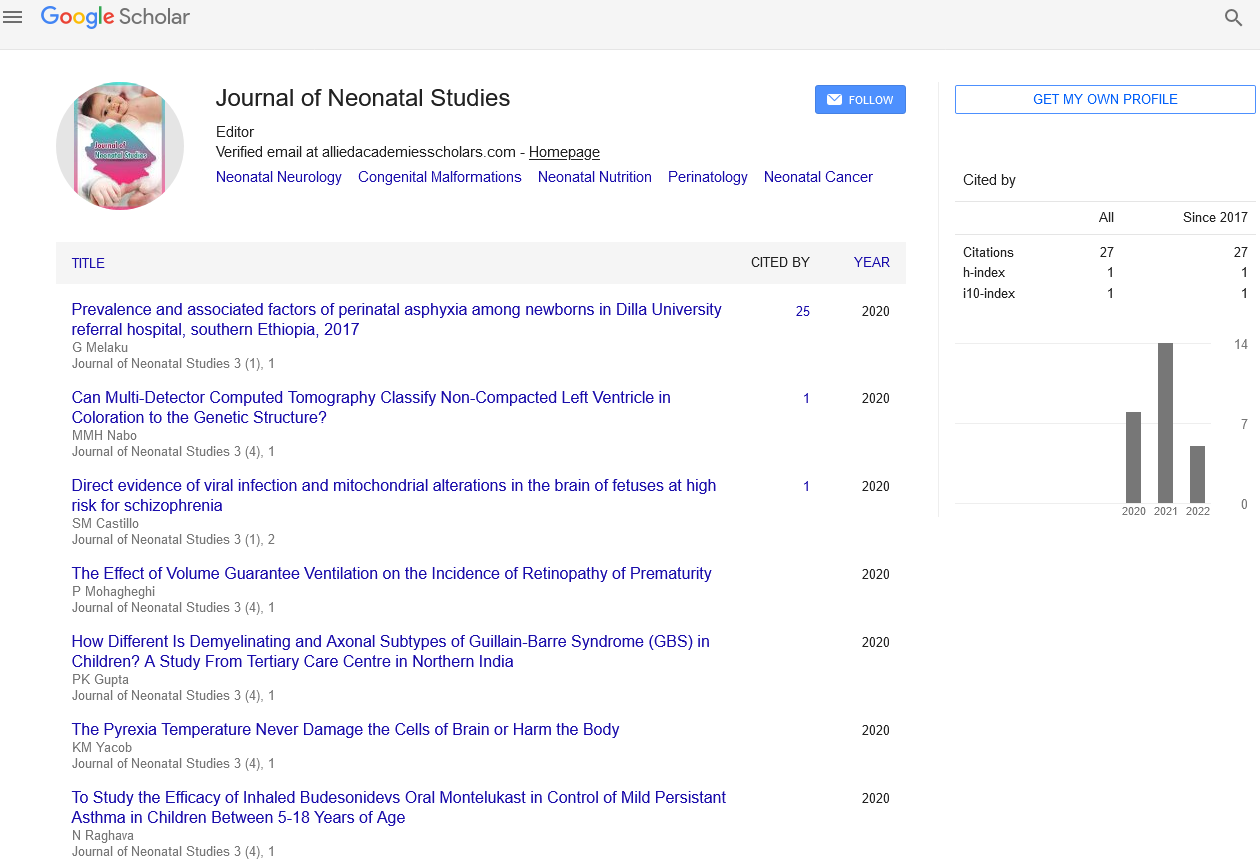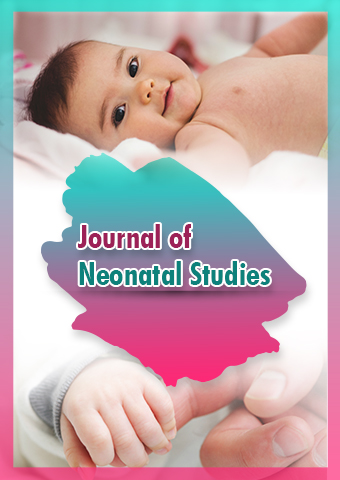Review Article - Journal of Neonatal Studies (2023) Volume 6, Issue 3
Neonatal Abstinence Syndrome (NAS): Understanding the Impact and Promoting Effective Management
Erovic Boban*
Neuro Cure Clinical Research Center, Charité Universitäts, Medizin Berlin, Berlin, Germany
Neuro Cure Clinical Research Center, Charité Universitäts, Medizin Berlin, Berlin, Germany
E-mail: pfueller.caspar@charite23.de
Received: 01-June-2023, Manuscript No. jns-23-104266; Editor assigned: 2-June-2023, PreQC No. jns-23- 104266(PQ); Reviewed: 15-June- 2023, QC No. jns-23-104266; Revised: 23-June-2023, Manuscript No. jns-23- 104266(R); Published: 30-June-2023; DOI: 10.37532/jns.2023.6(3).76-78
Abstract
Neonatal Abstinence Syndrome (NAS) is a complex and growing public health concern that affects infants exposed to substances, particularly opioids, during pregnancy. NAS occurs when infants experience withdrawal symptoms as a result of discontinuation of drug exposure after birth. This article aims to provide a comprehensive understanding of NAS, including its causes, symptoms, risk factors, and effective management strategies, with the ultimate goal of improving outcomes for affected infants and their families.
Keywords
Neonatal abstinence syndrome • Public health • Pregnancy • Birth • Newborn
Introduction
Understanding neonatal abstinence syndrome (Nas)
Causes and drug exposure
Nas primarily occurs when pregnant individuals use opioids, including prescription opioids, heroin, or opioid medications, leading to the transfer of these substances to the developing fetus through the placenta. prolonged exposure to opioids in utero results in physical dependence, causing withdrawal symptoms upon birth [1].
Symptoms and clinical presentation
Nas manifests as a constellation of physiological and neurological symptoms common signs include tremors, excessive crying, irritability, poor feeding, gastrointestinal disturbances, sweating, fever, and disturbed sleep patterns. Severity and duration of symptoms vary, and infants may require medical intervention and support to manage withdrawal symptoms effectively.
Risk factors
Several factors contribute to the risk of nas development in infants, including maternal opioid use, substance abuse during pregnancy, poly drug use, high opioid dosage, long duration of drug exposure, and limited prenatal care understanding these risk factors can help identify at-risk infants and guide appropriate interventions [2, 3].
Effective management of Nas
Non-pharmacological interventions
non-pharmacological approaches are the cornerstone of nas management and focus on providing a soothing, supportive environment for affected infants strategies such as swaddling, gentle rocking, minimizing environmental stimuli, and promoting skin-to-skin contact (kangaroo care) have shown to reduce withdrawal symptoms and enhance infant well-being.
Pharmacological treatment
in severe cases, pharmacological interventions may be necessary to alleviate withdrawal symptoms medications such as morphine or methadone, administered in controlled doses, can help manage withdrawal symptoms and facilitate the weaning process. the use of pharmacological interventions requires careful monitoring and a collaborative approach involving pediatricians and specialized healthcare providers [4].
Multidisciplinary care and support
Addressing nas comprehensively requires a multidisciplinary approach involving healthcare professionals, social workers, and addiction specialists collaborative efforts aim to provide comprehensive care for both the infant and the mother, focusing on managing withdrawal symptoms, addressing underlying maternal substance use disorder, and facilitating access to supportive services.
Supportive environment and family-centered care
Creating a supportive environment that recognizes the unique challenges faced by families affected by nas is crucial. Encouraging familycentered care, where healthcare providers work closely with parents, helps build trust, promote bonding, and support the emotional well-being of both the infant and the caregiver.
Prevention and education
Preventing nas necessitates a multi-faceted approach involving public health initiatives, education, and comprehensive substance abuse treatment programs enhancing access to prenatal care, promoting opioid use disorder screening and treatment, and educating healthcare providers on appropriate pain management strategies during pregnancy are essential steps in preventing nas [5].
Discussion
Neonatal abstinence syndrome (Nas) - a complex challenge in infant health
Neonatal abstinence syndrome (Nas) is a condition that occurs in newborn infants exposed to addictive substances, such as opioids, during pregnancy. Nas represents a significant public health concern, requiring a comprehensive understanding of its causes, symptoms, risk factors, and management strategies this discussion aims to shed light on the complexity of nas, explore its impact on infants and families, highlight prevention efforts, and discuss approaches to effective management [6].
Understanding neonatal abstinence syndrome (Nas)
Causes and drug exposure
Nas arises when pregnant individuals use opioids, including prescription opioids, heroin, or opioid medications, leading to the transfer of these substances to the developing fetus through the placenta the prolonged exposure to opioids in utero results in the infant becoming physically dependent on the drug.
Symptoms and clinical presentation
Infants with nas experience a range of symptoms as a result of withdrawal from the drugs they were exposed to in the womb common symptoms include tremors, irritability, excessive crying, poor feeding, gastrointestinal issues, sweating, fever, and disturbed sleep patterns the severity and duration of symptoms vary, with some infants requiring medical intervention to manage withdrawal symptoms effectively [7].
Risk factors
Various factors contribute to the risk of nas development in infants maternal opioid use, substance abuse during pregnancy, polydrug use, high opioid dosage, long duration of drug exposure, and limited prenatal care are among the primary risk factors identifying these risk factors is crucial for early identification and intervention.
Impact and challenges of Nas
Medical and developmental impact
Nas can have significant medical and developmental implications for affected infants the withdrawal symptoms can lead to difficulties with feeding, weight gain, and respiratory distress, requiring specialized care infants with nas may also be at an increased risk of developmental delays, behavioral issues, and long-term cognitive impairments.
Emotional and social impact
Nas not only affects the physical health of infants but also has emotional and social consequences for families. Parents may experience guilt, shame, and stigma associated with maternal substance use. Nas can strain parent-child bonding, disrupt family dynamics, and contribute to postpartum depression or anxiety in mothers [8, 9].
Approaches to effective management of Nas
Non-pharmacological interventions
Non-pharmacological interventions form the foundation of nas management techniques such as swaddling, gentle rocking, minimizing environmental stimuli, and promoting skin-toskin contact (kangaroo care) help soothe and comfort infants, reducing withdrawal symptoms and improving their well-being.
Pharmacological treatment
In severe cases of nas, pharmacological interventions may be necessary medications such as morphine or methadone are administered in controlled doses to alleviate withdrawal symptoms and support the weaning process. Pharmacological treatment should be carefully monitored and tailored to each infant’s needs.
Multidisciplinary care and support
Managing nas requires a multidisciplinary approach involving healthcare providers, social workers, addiction specialists, and other professionals collaboration between these experts helps address the complex needs of infants and their families, including monitoring and treating withdrawal symptoms, providing education and support, and facilitating access to necessary resources and services.
Prevention and education
Preventing nas is a crucial component of addressing this issue comprehensive prevention efforts include public health initiatives, education on the risks of substance use during pregnancy, increased access to prenatal care, and screening for substance use disorders additionally, promoting appropriate pain management strategies and expanding substance abuse treatment programs can contribute to reducing the incidence of nas [10].
Conclusion
Neonatal Abstinence Syndrome (NAS) represents a complex challenge in infant health, requiring a multifaceted and compassionate approach. By understanding the causes, symptoms, and risk factors associated. Neonatal Abstinence Syndrome (NAS) poses significant challenges for affected infants and their families. Understanding the causes, symptoms, and effective management strategies of NAS is crucial for improving outcomes and providing optimal care for these vulnerable infants. By implementing a comprehensive approach that includes non-pharmacological interventions, pharmacological treatment when necessary, multidisciplinary care, family-centered support, and prevention efforts, we can enhance the wellbeing of infants affected by NAS and promote their healthy development.
Acknowledgement
None
Conflict of Interest
None
References
- Muenzer J. Early initiation of enzyme replacement therapy for the mucopolysaccharidoses. Mol Genet Metab. 111, 63-72 (2014).
- Concolino D, Federica Deodato F, Parin R. Enzyme replacement therapy: Efficacy and limitations. Ital J Pediatr. 44, 120 (2018).
- Tomatsu S, Alméciga Díaz CJ, Montaño AM et al. Therapies for the bone in mucopolysaccharidoses. Mol Genet Metab. 114, 94-109 (2015).
- Al-Sannaa NA, Bay L, Barbouth DS et al. Early treatment with laronidase improves clinical outcomes in patients with attenuated MPS I: A retrospective case series analysis of nine sibships. Orphanet J Rare Dis. 10, 131 (2015).
- Chuang CK, Lin HY, Wang TJ et al. Status of newborn screening and follow up investigations for Mucopolysaccharidoses I and II in Taiwan. Orphanet J Rare Dis. 13, 84 (2018).
- Harrison SM, Heidi L, Rehm HL. Is ‘likely pathogenic’ really 90% likely? Reclassification data in ClinVar. Genome Med.11, 72 (2019).
- Lin HY, Tu RY, Chern SR et al. Identification and functional characterization of IDS gene mutations underlying Taiwanese Hunter Syndrome (mucopolysaccharidosis type II). Int J Mol Sci. 21, 114 (2020).
- Chuang CK, Lin HY, Wang TJ et al. A modified liquid chromatography/tandem mass spectrometry method for predominant disaccharide units of urinary glycosaminoglycans in patients with mucopolysaccharidoses. Orphanet J Rare Dis. 9, 135 (2014).
- Lin HY, Lo YT, Wang TJ et al. Normalization of glycosaminoglycan-derived disaccharides detected by tandem mass spectrometry assay for the diagnosis of mucopolysaccharidosis. Sci Rep. 9, 10755 (2019).
- Chuang CK, Lin SP, Chung SF. Diagnostic Screening for Mucopolysaccharidoses by the Dimethylmethylene Blue Method and Two Dimensional Electrophoresis. Chin Med J. 64, 15-22 (2001).
Indexed at, Google Scholar, Crossref
Indexed at, Google Scholar, Crossref
Indexed at, Google Scholar, Crossref
Indexed at, Google Scholar, Crossref
Indexed at, Google Scholar, Crossref
Indexed at, Google Scholar, Crossref
Indexed at, Google Scholar, Crossref
Indexed at, Google Scholar, Crossref
Indexed at, Google Scholar, Crossref

